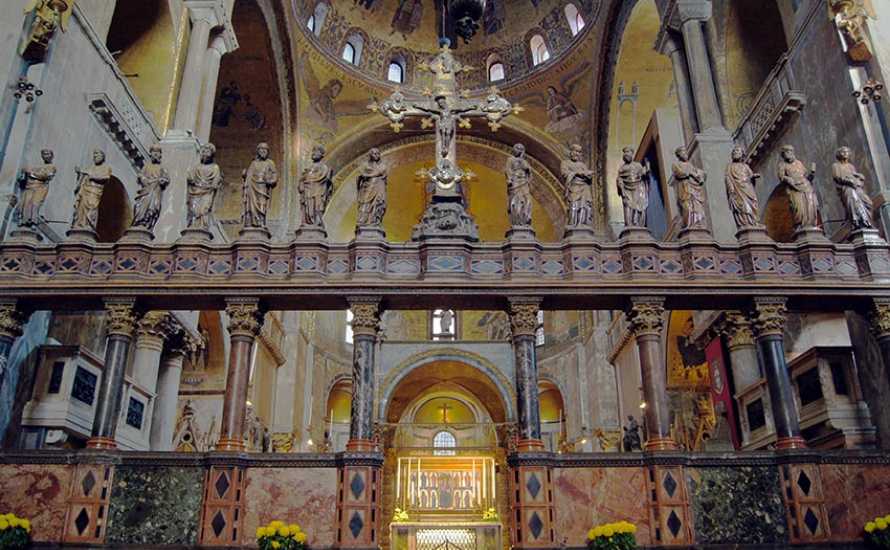Located on St. Marks Square and next to Doges Palace, St. Marks Basilica is the best-known examples of Italo-Byzantine architecture.
This Basilica is fabulous from every aspect, From the ornate detail, amazing sculptures and artwork of the front facade, to the beautifully designed frescoes and Byzantine artworks.
General Information
Visitors are advised to respect the basilica by wearing appropriate clothes for a place of worship
Do not enter the basilica with luggage. Luggage must be deposited in Ateneo San Basso (near north façade).
You are also not allowed to take Photos inside the basilica
When to go?
Venice is always full of visitors during summer and the best time to visit the Basilica in summers is early in the morning when basilica opens and when the lights are turned on to illuminate the mosaics.
Timings for St. Marks Basilica
From October 29 – April 15
Basilica:
9:30 AM – 5:00 PM: Monday to Friday
2:00 PM – 4:30 PM: Sunday and holidays
St. Mark’s Museum:
9:45 AM – 4:45 PM: Every Day
Pala d’oro:
9:45 AM – 4:45 PM: Monday to Friday
2:00 PM – 4:30 PM: Sunday and holidays
Treasury:
9:45 AM – 4:45 PM: Monday to Friday
2:00 PM – 4:30 PM: Sunday and holidays
From April 16 to October 28:
Basilica:
9:30 AM – 5:00 PM: Monday to Friday
2:00 PM – 5:00 PM: Sunday and Holidays
St. Mark’s Museum:
9:35 AM – 5:00 PM: Every Day
Pala d’oro:
9:35 AM – 5:00 PM: Monday to Friday
2:00 AM – 5:00 PM: Sunday and holidays:
Treasury:
9:35 AM – 5:00 PM: Monday to Friday
2:00 AM – 5:00 PM: Sunday and Holidays
Entrance
You need to purchase a ticket for accessing Museums and Bell Tower
Tickets
Book tickets in advance either from ticket counter or from online platforms.
Tickets for Saint Marks Basilica are categorized into 3 types:
Regular or Full Tickets:
For non-European Citizens: 18 and above years of age
For European Citizen: 25 and above years of age
Reduced or Half Tickets:
For European Citizen: 18 to 25 years of age (Please come with valid documents whihc will be needed at the entrance).
For Teachers from European Public Institute with valid proof.
Free Tickets:
For Minors under 18 (It is for both European and Non-European Citizens)
For Physical handicap disabled Certified persons
For Journalist with valid ID proof
For ICOM (International Council of Museums) Members:
Note: Please check in which ticket slab you fit in before purchasing a ticket and enjoy the benefits.
Guided Tours
The entrance to Basilica is free, but you have to stand very long in line, so it is recommended to book a guided tour to avoid waiting in a queue. Guided tour also includes the tickets for a museum, treasury of st. Marks and bell tower.
You can book Guided Tour from nearby travel agencies but the best way to book guided tours are online platforms.
Inside St. Marks Basilica
Pala d’Oro – It is high altar retable of Saint Mark’s Basilica and universally considered to be the most precious and accomplished works of Byzantine enamel.
Treasury – Treasury of St. Marks contains the unique collection from Antiquity art, Byzantine art, Islamic art and Western art.
Museo di San Marco – It exhibits a collection of objects which belongs to basilica which includes four bronze horses of St Mark.
Marble Inlays – Covering area of more than 2099 sq.mt. Basilica floor is furnished with a marble designed in geometric patterns.
Some Facts about St. Marks Basilica
Also known as Patriarchal Cathedral Basilica of Saint Mark, is the most famous church in the whole of Venice.
It was ordered in Dodge in 828 and completed in 832. During the rebellion, it was burned in 976 and was restored in 1063, under Doge Domenico Contarini. The complete construction was finished in 1096.
It is located on St. Marks Square and sitting just next to Doges Palace.
It was the doge’s residential place until 1807 when it became the famous city’s cathedral.
Because of its opulent design, gold ground mosaics, St. Mark’s Basilica has also been known with nicknamed as Chiesa d’Oro (Church of Gold).
The Bronze Horses of Saint Mark, also known as Triumphal Quadriga were installed on St Mark’s Cathedral in 1254.

Be the first to write a comment.